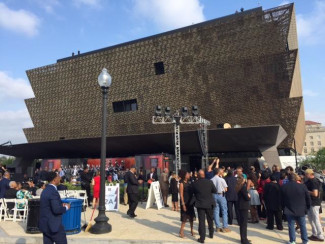
Johns Hopkins UniversityEst. 1876
America’s First Research University
A New Smithsonian Museum

By Bob Post
My friend at the MIT Museum, Deborah Douglas, describes Who Owns America’s Past? as “part history, part memoir, part polemic.” Such a trifurcation was not really on my mind as I wrote, but now I know Debbie is spot on. The polemic concerns, first, a crisis of representation at the National Air and Space Museum: “For whatever it costs to buy influence, you can now have your own version of our nation’s history displayed and opposing views suppressed,” wrote an embittered former director, Martin Harwit. Second, it concerned the Smithsonian falling under the thrall of Lawrence Small, a man whose “attitude and disposition were ill suited to public service,” as a review committee put it way too mildly. The picture had brightened as I got to my concluding pages, with the institution’s leadership now in the hands of a scholar true to the ideals of public service, G. Wayne Clough. And yet Clough had somehow been tempted into the murky voodoo of “branding,” with a plan to stake the Smithsonian’s identity on the phrase “Simply Amazing.” I wondered how anything so dreadfully trite could have meaning with respect, say, to a Smithsonian exhibit on gay and lesbian themes in American art. Or, to my point here, when it came to many exhibits slated for the Smithsonian’s newest museum, the National Museum of African American History and Culture.
The NMAAHC’s building was nearing completion when my book first came out—a design unlike anything else in Smithsonian precincts, intended “to evoke the art of an ancient African kingdom.” Many exhibits were still not set, but already there was a Jim Crow railroad coach and a guard tower from Louisiana’s notorious Angola Prison: 6,000 inmates, 76 percent black, most serving life terms. There was to be a slave cabin, shackles and whips, photos of lynchings. A stone block from which men and women were bought and sold, bid on like cattle. Emmett Till’s coffin. So at odds were such artifacts with the Smithsonian’s new million-dollar brand that it was all but forgotten by the time the NMAAHC opened in late September 2016. Still, it was hard to escape a sense that indeed there was something amazing about the realization of this museum, first envisioned a century ago, and now finally in place in the shadow of the Washington Monument. Yes, there were joyful artifacts such as Chuck Berry’s cherry red Eldorado, but on the museum’s first level there were dreadful evocations of slavery, segregation, and the dark side of race relations to this day—this even after dark-side themes in other museums, notably the Air and Space Museum’s Enola Gay exhibit, had been squelched by self-proclaimed “stakeholders,” abetted by politicians who saw a superpatriotic plum ready for plucking. No Smithsonian exhibit should ever, could ever, address the dark side of history so boldly, so went the argument.
Much of the NMAAHC disclosed stories and images that were terribly dark, and yet the new museum was almost universally celebrated at first, not condemned. Blair L.M. Kelly, a professor at North Carolina State University, confessed that he had been concerned about what the NMAAHC “might have intentionally left out or inadvertently forgotten.” His concerns were unfounded. “The museum succeeds,” Kelly wrote, “by grappling in an elegant fashion, with the many strands—sometimes uncomfortable, sometimes uplifting—of African American History and how closely they’re interwoven with the American experiment from its inception.”
For myself, I was happy that the Smithsonian, mired in controversy and bad press for some twenty years, had a new museum judged to be brilliantly conceived and executed as both a dramatic and educational experience. Most of the opening-day crowd had no hope of getting inside. They gathered partly because it was a beautiful day and they knew celebrities would be everywhere—Oprah Winfrey and Michael Jordan were big donors—but largely because of the formal dedication, to be delivered by the first black chief executive of the United States. Several times President Obama repeated the words of Langston Hughes, “I, too, am America,” and he was eloquent and persuasive and inspiring. Nobody present was disappointed. Everybody who was not should watch the video of Obama’s marvelous address.

In my book I concluded that American history seen through the African American experience had the power to fulfill a didactic mission more provocative than that of any other Smithsonian museum. But one cannot read the Youtube comments on Obama’s address, sometimes admiring, more often profane and hateful, not to understand that not everyone believes the NMAAHC makes America a better place, or even that it deserves to exist. As we move into a post-Obama world, it will stoke old controversies about identity politics. So, what group feels entitled to its own museum now? At worst, it may summon evil reprisals about “political correctness,” of the sort that are coin of the realm with Obama’s successor, not restrained by scruple. The Smithsonian’s newest museum may be assaulted by foes far nastier than those who beset the Air and Space Museum in the 1990s. President Obama expressed a hope that the new museum “can help us talk to each other. And more importantly, listen to each other.” One wonders. We’ve not been doing well at this lately. But if it’s at all possible, the new museum may play a helpful role, even as the euphoria of newness slips away. One hopes.
Bob Post, who fulfilled a variety of assignments at the Smithsonian for twenty-five years, is the author of Who Owns America’s Past? The Smithsonian and the Problem of History, first published by Johns Hopkins in 2013 and now reissued in a paperback edition.


